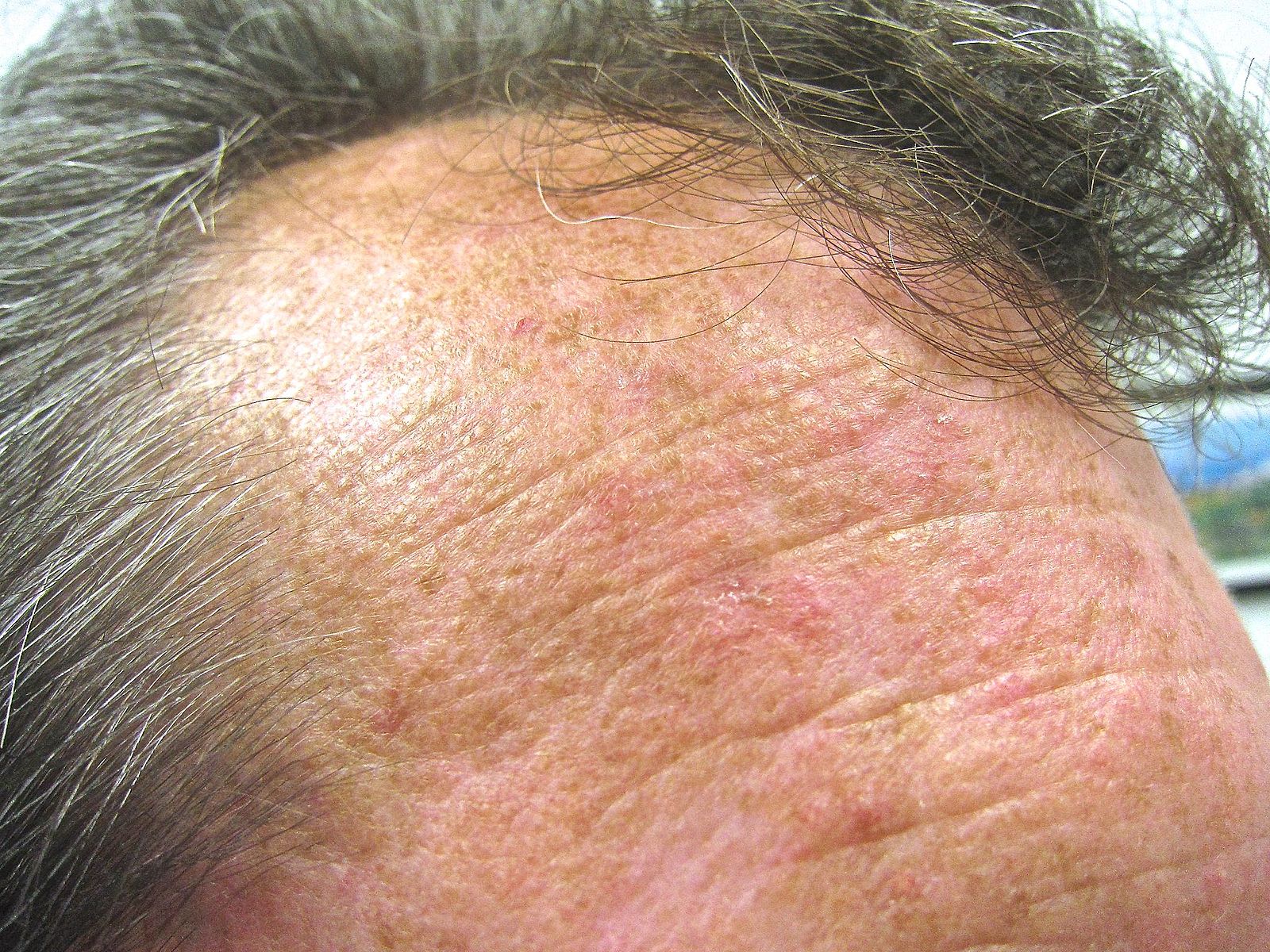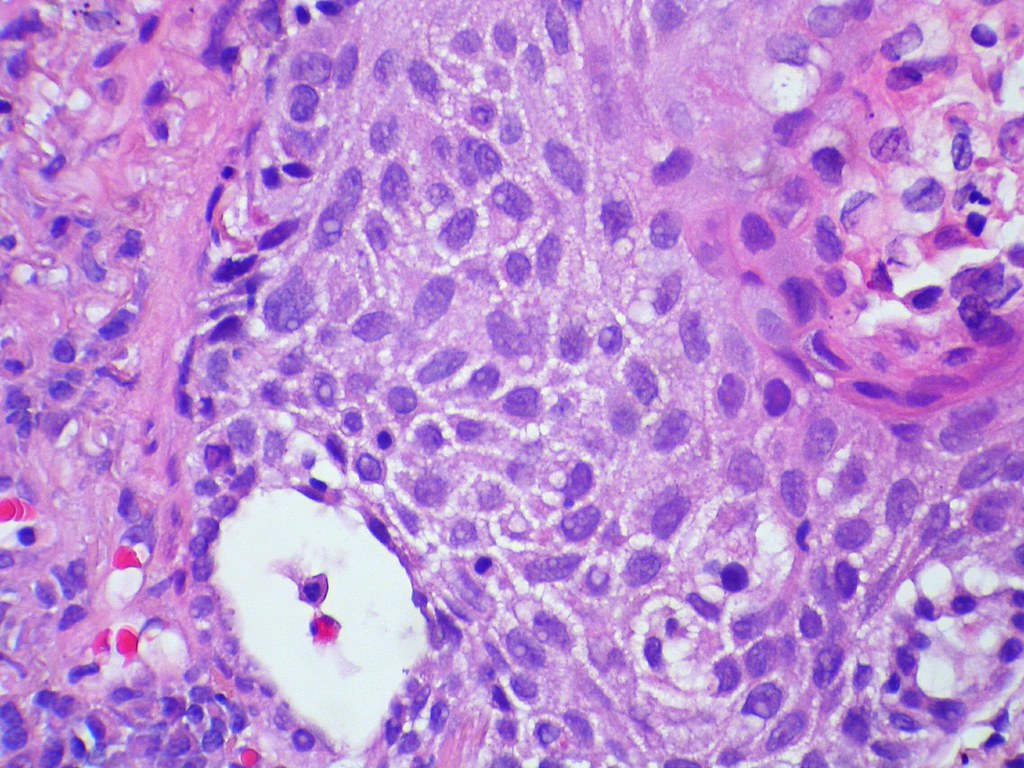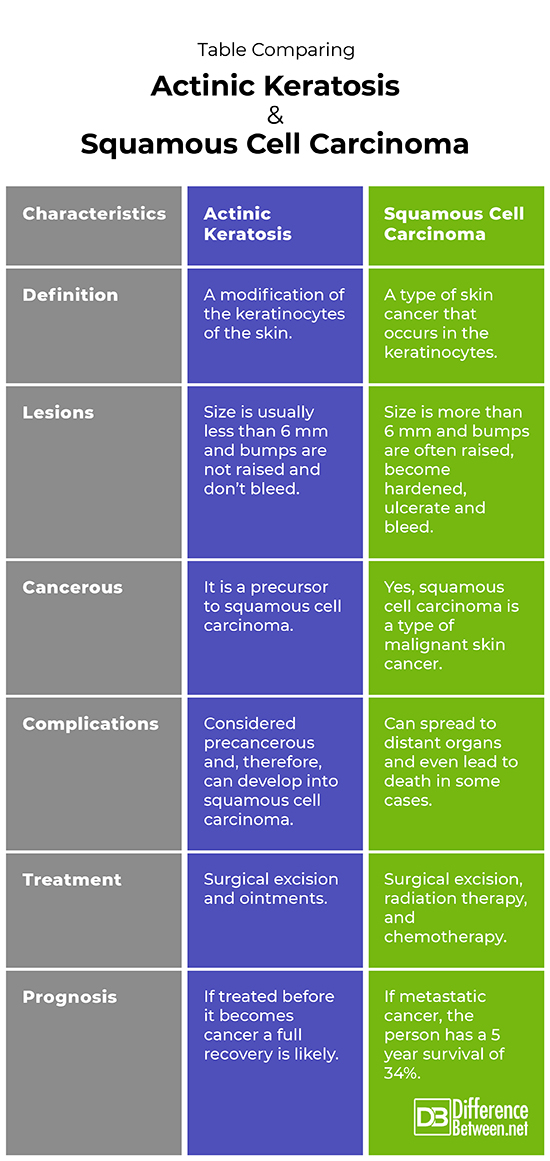Difference Between Actinic Keratosis and Squamous Cell Carcinoma
Actinic keratosis is the condition that occurs due to a change in the skin keratinocytes in the epidermis. Squamous cell carcinoma is a type of skin cancer that affects the keratinocytes.

What is Actinic Keratosis?
Definition:
Actinic keratosis is an alteration of keratinocytes, skin cells, due to several years of exposure to ultraviolet radiation from the sun or tanning beds.
Causes and prevalence:
The skin condition actinic keratosis is a result of long-term sun exposure that results in genetic change in the skin cells. The condition happens most often to people with fair skin and red or blonde hair and blue eyes that are older than 40 years.
Symptoms and complications:
The main symptom is the presence of scaly and roughened patches of dry skin that are smaller than 2.5 cm in size. Skin patches can be flat or only slightly elevated and may feel itchy and may start bleeding or forming a crust. The patches most often occur on parts of the body regularly exposed to sunlight, such as the hands, face, ears, and arms. The color of skin patches is also variable from pink to brown or reddish and the patches feel rough to the touch. Actinic keratosis is a precancerous condition meaning that it can lead to future skin cancer.
Diagnosis:
Dermatologists can tentatively diagnose actinic keratosis by a physical exam of the skin. A biopsy of the patch of skin can confirm the diagnosis.
Treatment:
The first step a patient should take is to avoid the sun and wear clothing that blocks UV radiation. Sunscreen should be worn when going out in the sun, and patients must not use tanning beds. Photoaging treatments include using various skin creams that contain the substances, tretinoin and alpha-hydroxy acids. Lesions can be removed using cryotherapy or electrocautery.

What is Squamous cell carcinoma?
Definition:
Squamous cell carcinoma is a cancer of the skin involving cells called epidermal keratinocytes.
Causes and prevalence:
Exposure to ultraviolet radiation is associated with this type of skin cancer since the UV triggers mutations in the p53 and p63 genes, which both have important functions in keeping the skin healthy. It is most common in people with fair skin and red hair color. This is because darker skin pigmentation provides more protection from UV radiation.
Symptoms and complications:
The presence of raised, red areas of skin that may be scaly or crusted is a symptom of this type of cancer. The sore often ulcerates and also extends downwards into the lower layers of the skin. Although not common, the cancer can spread to other organs especially if the lesions are deeper than 2 cm and larger than 2 cm. This metastasis can result in death.
Diagnosis:
A dermatologist should examine the skin and take a biopsy of the lesion. This is then examined under a microscope to see if the cells are cancerous.
Treatment:
Squamous cell carcinoma can be surgically removed, which works well if the cancer has not metastasized. Radiation therapy may be needed for large tumors that have spread, and sometimes with metastatic carcinoma, chemotherapy may be recommended.
Difference between Actinic keratosis and Squamous cell carcinoma?
Definition
Actinic keratosis is a skin condition in which there are changes that have taken place in the epidermal keratinocytes. Squamous cell carcinoma is a type of skin cancer that occurs in the keratinocytes.
Lesions
The lesions of actinic keratosis are smaller than 6 mm in size and the bumps do not bleed and are not too elevated. The lesions of squamous cell carcinoma are larger than 6 mm in diameter, they tend to be raised and bleed.
Cancerous
Actinic keratosis is not skin cancer but it is often a precursor condition leading to cancer. Squamous cell carcinoma is skin cancer that is malignant and can spread to distant organs.
Complications
Actinic keratosis needs to be treated because it is often a precursor to squamous cell carcinoma. Squamous cell carcinoma can, on occasion, spread to distant tissues and organs and lead to death.
Treatment
Treatment of actinic keratosis entails surgical removal of lesions and the use of various skin ointments. Treatment of squamous cell carcinoma involves surgery to cut out cancerous pieces of skin and potentially also chemotherapy and radiation treatment.
Prognosis
In the case of actinic keratosis, the prognosis is good if lesions are surgically removed and the skin carefully monitored to avoid the progression to skin cancer. In the case of squamous cell carcinoma, prognosis is good if the cancer is caught at an early stage because once metastasis has occurred, the 5 year survival drops to about 34%.
Table comparing Actinic keratosis and Squamous cell carcinoma

Summary of Actinic keratosis Vs. Squamous cell carcinoma
- Actinic keratosis and squamous cell carcinoma are both skin conditions that affect the keratinocyte cells.
- Actinic keratosis is a precursor to squamous cell carcinoma.
- Both squamous cell carcinoma and actinic keratosis are a result of excessive exposure to UV radiation.
- Avoiding too much sun exposure, particularly if you have fair skin is a way to help prevent these skin problems.
- Difference Between Rumination and Regurgitation - June 13, 2024
- Difference Between Pyelectasis and Hydronephrosis - June 4, 2024
- Difference Between Cellulitis and Erysipelas - June 1, 2024
Search DifferenceBetween.net :
Leave a Response
References :
[0]Benedetti, Julia. “Overview of effects of sunlight”. Merckmanuals. Merck & Co., 2019,https://www.msdmanuals.com/professional/dermatologic-disorders/reactions-to-sunlight/overview-of-effects-of-sunlight
[1]Gallagher, Richard P., et al. "Sunlight exposure, pigmentation factors, and risk of nonmelanocytic skin cancer: II. Squamous cell carcinoma." Archives of dermatology 131.2 (1995): 164-169.
[2]Wells, Gregory L. “Squamous Cell Carcinoma”. Merckmanuals. Merck & Co., 2020, https://www.merckmanuals.com/professional/dermatologic-disorders/cancers-of-the-skin/squamous-cell-carcinoma
[3]Image credit: https://live.staticflickr.com/5445/9723773829_2d33a3a1ec_b.jpg
[4]Image credit: https://commons.wikimedia.org/wiki/File:Actinic_keratoses_on_forehead.JPG
